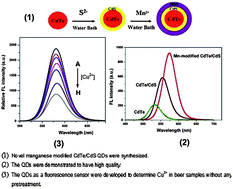Manganese modified CdTe/CdS quantum dots as a highly selective probe to detect trace copper element in beer samples
Abstract
This paper describes the investigation of manganese modified CdTe/CdS

* Corresponding authors
a
School of Pharmacy, Nanjing Medical University, Nanjing, , Jiangsu 210029, PR China
E-mail:
huqin@njmu.edu.cn
Fax: +86-2586862031
Tel: +86-2586862031
b School of Public Health, Nanjing Medical University, Nanjing, Jiangsu 210029, PR China
This paper describes the investigation of manganese modified CdTe/CdS

 Please wait while we load your content...
Something went wrong. Try again?
Please wait while we load your content...
Something went wrong. Try again?
F. Wei, H. Yu, M. Hu, G. Xu, Z. Cai, J. Yang, L. Li and Q. Hu, Anal. Methods, 2012, 4, 1438 DOI: 10.1039/C2AY05794H
To request permission to reproduce material from this article, please go to the Copyright Clearance Center request page.
If you are an author contributing to an RSC publication, you do not need to request permission provided correct acknowledgement is given.
If you are the author of this article, you do not need to request permission to reproduce figures and diagrams provided correct acknowledgement is given. If you want to reproduce the whole article in a third-party publication (excluding your thesis/dissertation for which permission is not required) please go to the Copyright Clearance Center request page.
Read more about how to correctly acknowledge RSC content.
 Fetching data from CrossRef.
Fetching data from CrossRef.
This may take some time to load.
Loading related content
